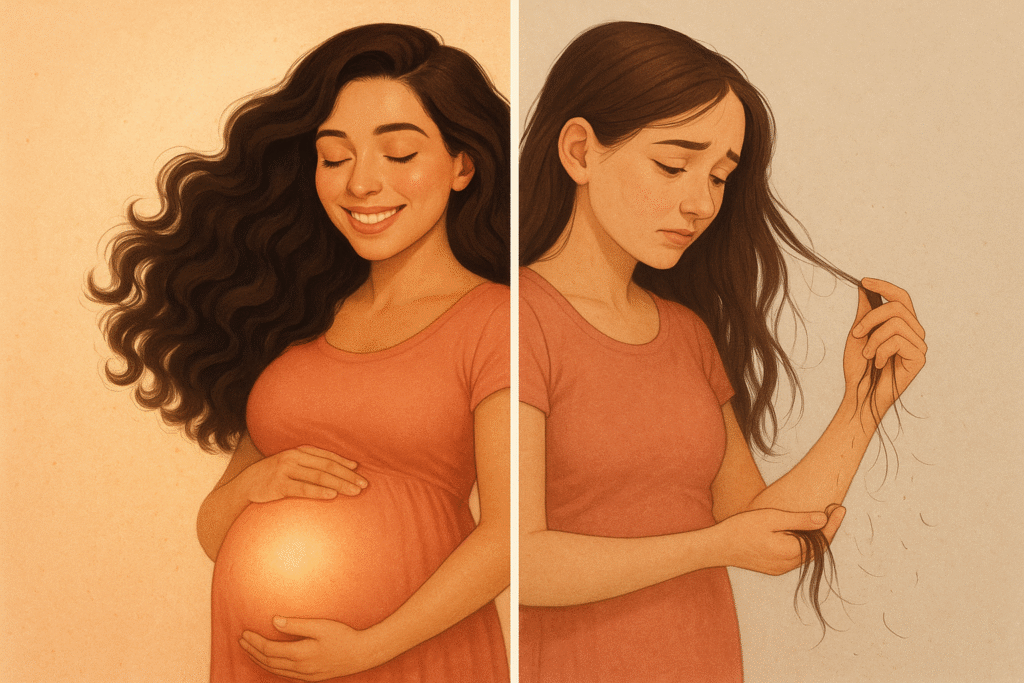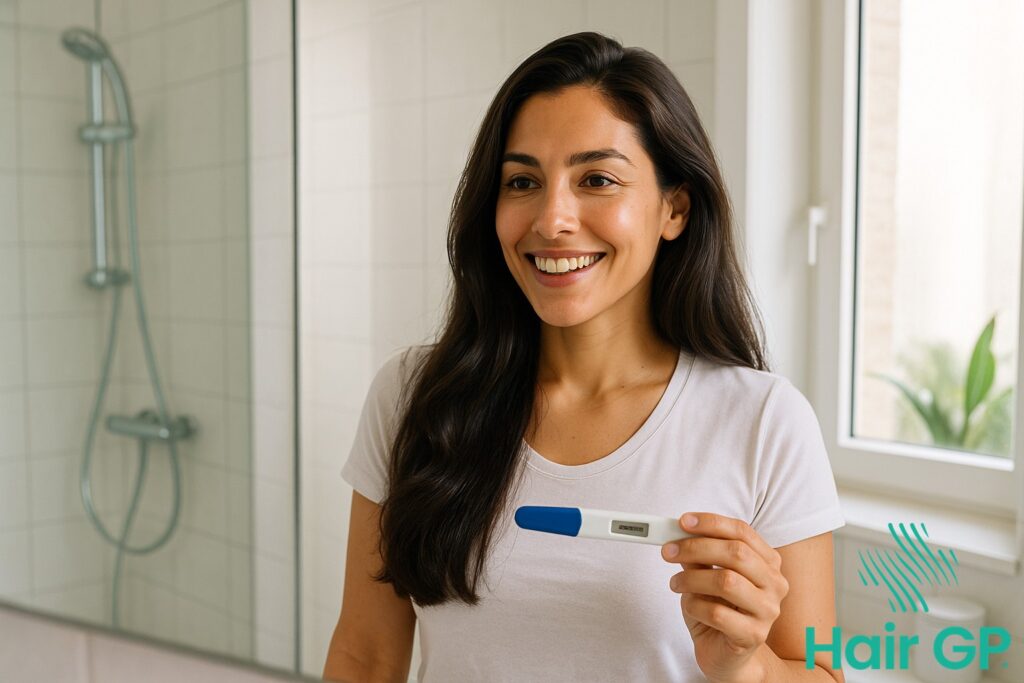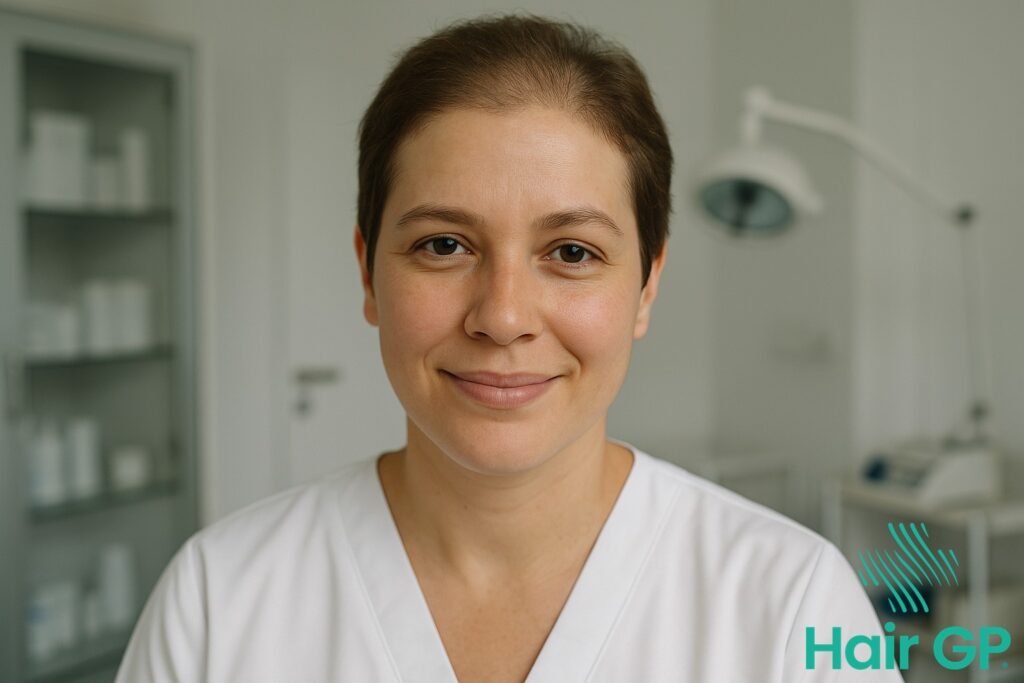Introduction
Many expectant mothers experience one of pregnancy’s most welcome surprises: the coveted pregnancy hair glow. This phenomenon transforms hair into something that appears thicker, shinier, and more lustrous than ever before. But this beautiful change comes with a catch – what goes up must come down, and the enviable locks that flourish during pregnancy often give way to noticeable postpartum hair loss.
Understanding these dramatic hair changes begins with recognizing the powerful role of pregnancy hormones. Rising estrogen and progesterone levels work together to alter your hair’s natural growth cycle, creating conditions that favor fuller, healthier-looking hair. These hormonal shifts don’t happen overnight, and neither do their effects on your appearance.
The timeline of these transformations follows a predictable pattern. Hair improvements typically become noticeable during the second trimester, reaching their peak in the third trimester. However, after delivery, hormonal levels plummet, triggering a cascade of changes that can lead to significant hair shedding within months of giving birth.
This article explores the fascinating science behind pregnancy’s effect on hair, from the cellular mechanisms that create thicker strands to the biological processes that cause postpartum shedding. We’ll walk through the timeline of what to expect during each phase, explain when hair loss typically begins and resolves, and provide practical strategies for managing both the glorious pregnancy phase and the challenging postpartum period. Understanding these natural processes can help set realistic expectations and reduce anxiety about this temporary but dramatic change.
Key Takeaways – TL/DR
- Pregnancy hormones cause hair to grow thicker and shinier by extending the growth phase
- Most pregnant women experience less hair shedding during pregnancy, creating fuller hair
- Postpartum hair loss typically begins 3-6 months after giving birth and is completely normal
- Hair usually returns to pre-pregnancy state within 12-18 months after childbirth
What Causes the Pregnancy Hair Glow
The pregnancy glow that transforms hair into a thick, lustrous crown stems from dramatic hormonal shifts that fundamentally alter the hair growth cycle. Rising estrogen levels during pregnancy play the starring role in this transformation, extending the anagen (growth) phase of hair follicles while simultaneously reducing the number of hairs entering the telogen (resting) phase [1]. This hormonal orchestration means that hair that would normally shed continues growing, creating the appearance of significantly thicker, fuller hair.
Progesterone works alongside estrogen to enhance this effect, contributing to improved hair texture and increased sebum production that gives hair its characteristic shine and smoothness. These elevated hormone levels, which can increase by 10-fold during pregnancy, create an optimal environment for hair retention [2]. The hair growth cycle, typically lasting 2-7 years, becomes disrupted in the most beneficial way possible – fewer hairs complete their natural shedding cycle, while existing strands continue to grow and strengthen.
This hormonal symphony explains why many women experience the most beautiful hair of their lives during pregnancy. The pregnancy glow isn’t just about facial radiance; it encompasses the entire hair transformation that occurs when rising estrogen levels and progesterone work together to pause normal hair loss patterns.

When Hair Changes Begin During Pregnancy
Hair transformations during pregnancy follow a predictable and exciting timeline that many expectant mothers find absolutely delightful. These remarkable changes typically begin subtly during early pregnancy and progressively intensify, reaching their magnificent peak during the second and third trimesters when hormonal effects are strongest.
First Trimester Changes
During the first trimester, pregnant women often notice the earliest encouraging signs of meaningful hair improvement. Reduced daily hair loss becomes readily apparent as significantly fewer strands collect in hairbrushes and shower drains throughout the day. Hair texture begins showing slight but noticeable improvement in natural shine and overall health. Many women report that their hair feels considerably less brittle and more manageable during this transformative early pregnancy period.
Second and Third Trimester Peak
The second trimester marks when the most dramatic and stunning hair transformations occur for most expectant mothers. Peak hormone levels during this crucial time create maximum hair retention, leading to noticeably fuller, thicker-looking hair that amazes both women and their loved ones. Pregnant women frequently experience their hair’s most lustrous and vibrant appearance during these later months, with enhanced volume and a healthy, enviable glow.
The Science Behind Thicker, Fuller Hair
The remarkable transformation to thicker hair during pregnancy stems from fundamental changes in hair follicle biology and the natural hair growth cycle. Each hair follicle operates through three distinct phases: anagen (active growth), catagen (transition), and telogen (resting phase). Under normal circumstances, approximately 85-90% of hair follicles remain in the anagen phase, which typically lasts 2-6 years, while 10-15% enter the shorter telogen phase lasting 2-3 months[3].
Pregnancy hormones dramatically alter this delicate balance at the cellular level. Elevated estrogen and progesterone levels work synergistically to extend the anagen phase significantly, keeping hair follicles in their active growth state for longer periods. This hormonal surge also suppresses the transition from anagen to telogen phase, effectively reducing the number of hair follicles entering the resting state[4]. The result is a substantially higher percentage of follicles remaining in active growth simultaneously.
At the follicular level, these hormones enhance cellular proliferation within the hair matrix, the region responsible for hair shaft production. The increased metabolic activity stimulates keratinocyte division and promotes more robust hair fiber formation. Additionally, pregnancy hormones improve blood circulation to hair follicles, delivering enhanced nutrients and oxygen that support optimal follicular function. This complex interplay of hormonal influences creates the ideal environment for thicker hair production, maximizing both the number of active follicles and their individual growth potential.
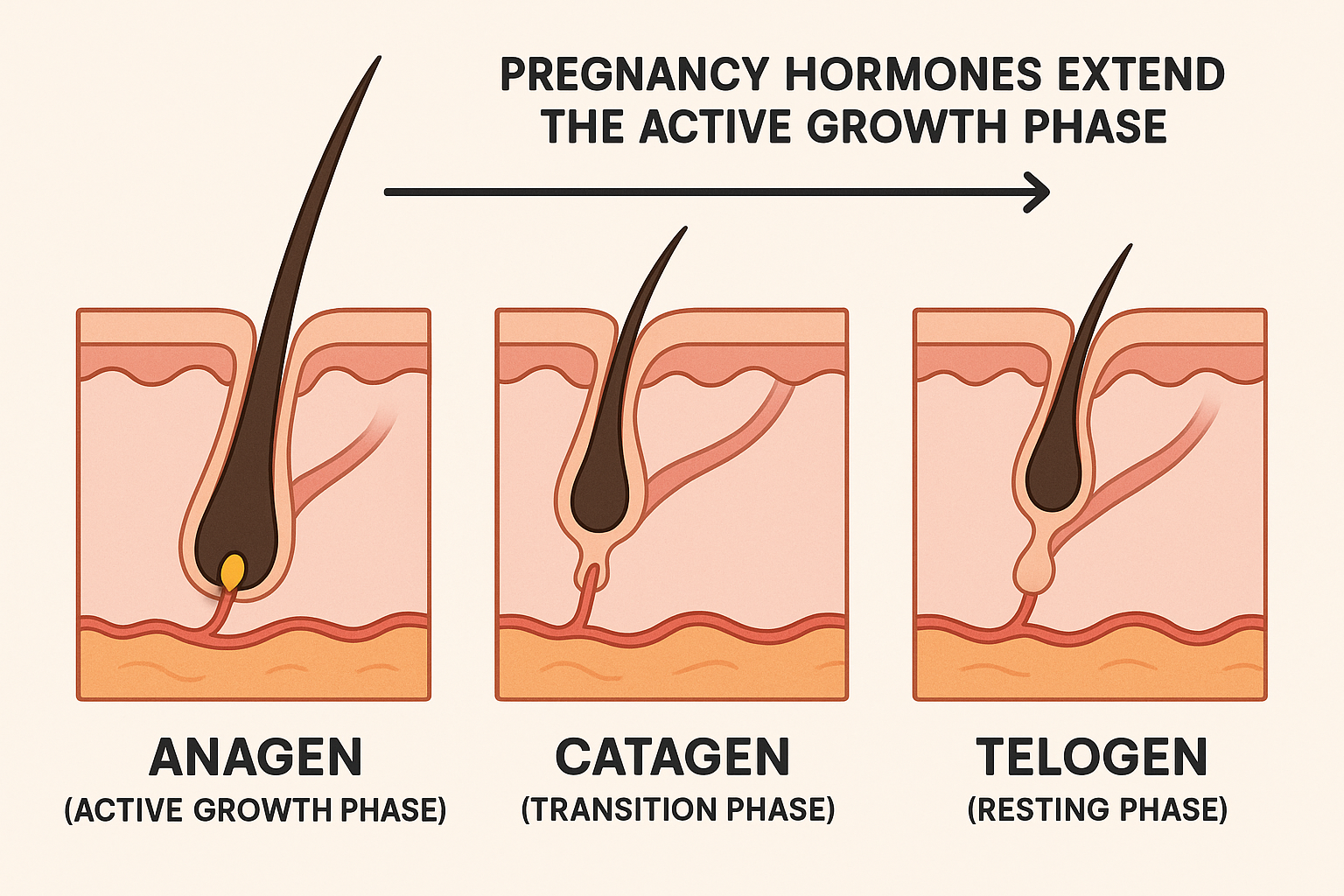
What Happens After Giving Birth
After giving birth, the dramatic hormonal shifts that created pregnancy’s luscious hair immediately reverse course, triggering significant changes in the hair growth cycle. Oestrogen levels plummet rapidly in the days following delivery, causing hair follicles that remained in the extended growth phase during pregnancy to suddenly shift into the telogen (resting) phase. This hormonal crash disrupts the normal hair cycle that pregnancy had temporarily suspended.
The result is postpartum hair loss, medically known as telogen effluvium, which affects approximately 40-50% of women within 2-4 months after giving birth [1]. During this phase, women experience significant hair shedding as follicles that should have naturally shed throughout pregnancy finally release their grip. This process can be alarming, with some women losing 300-500 hairs daily compared to the normal 50-100 hairs.
The biological mechanism behind postpartum hair loss involves the synchronized transition of hair follicles from anagen to telogen phase, creating a mass shedding event [5]. This telogen effluvium typically peaks around 3-4 months postpartum before gradually subsiding. The hair growth cycle slowly normalizes as hormone levels stabilize, usually returning to pre-pregnancy patterns within 6-12 months after giving birth, though complete recovery may take up to 18 months.
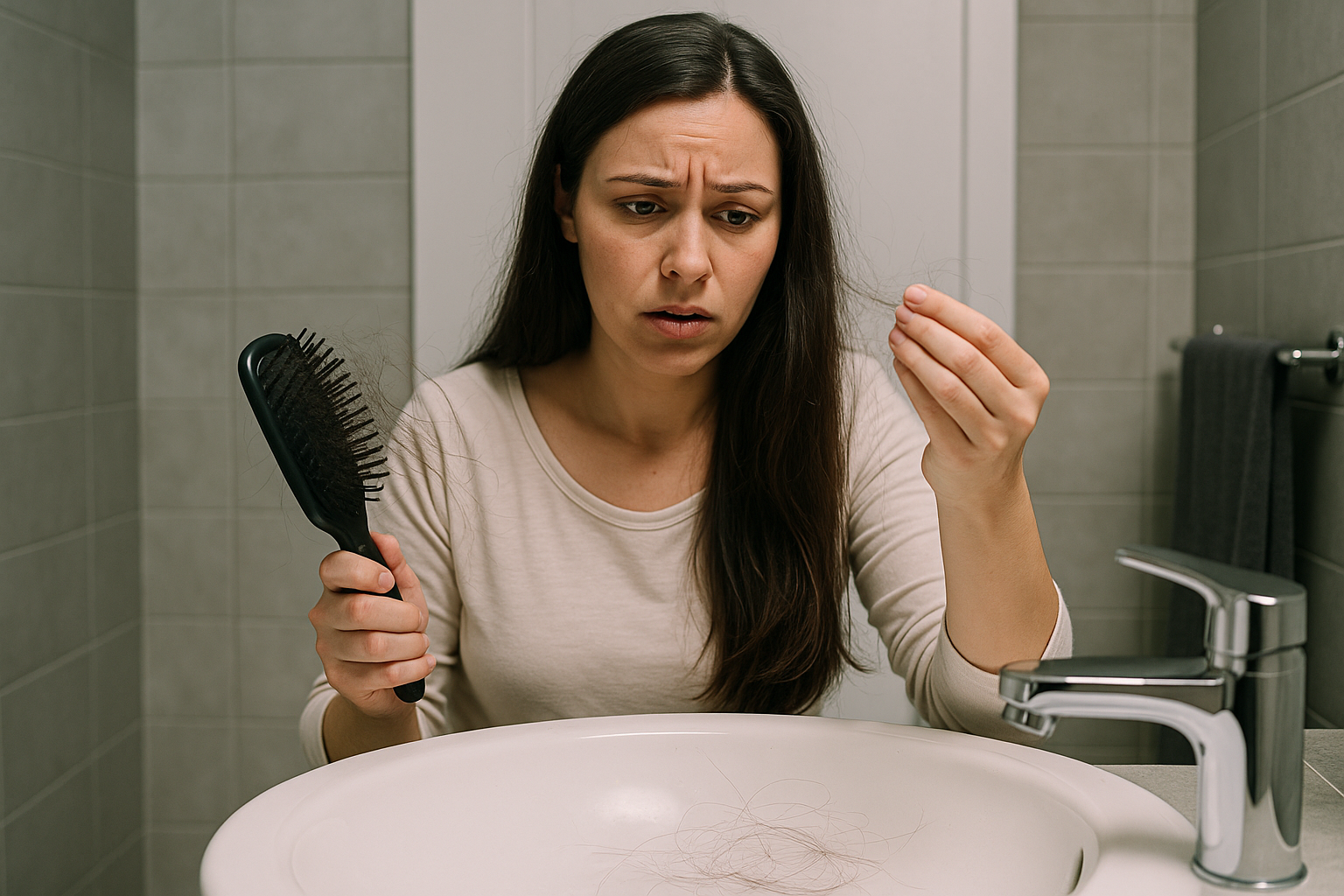
Timeline of Postpartum Hair Loss
Understanding the timeline of postpartum hair loss helps new mothers navigate this natural process with confidence. Hair loss following childbirth follows a predictable pattern, typically beginning around three months after delivery and gradually resolving within the first year.
3-6 Months Post-Birth
This period represents the peak phase of postpartum hair loss, when shedding reaches its maximum intensity. Many women notice significantly more hair in their brush, shower drain, and on their pillow during this time. The hair loss can be quite dramatic, with some mothers losing up to one-third of their hair volume. This noticeable thinning particularly affects the hairline and crown area, where pregnancy hormones had previously encouraged extra growth. Despite how alarming this shedding may appear, it’s important to remember this is a completely temporary phase that affects most new mothers.
6-12 Months Recovery
The recovery phase brings welcome relief as hair shedding gradually decreases and normal growth patterns resume. New hair growth becomes increasingly visible, often appearing as short, fine strands around the hairline. Hair texture typically begins normalizing during this period, returning to pre-pregnancy characteristics. By twelve months postpartum, most women notice their hair density approaching normal levels, though complete recovery may extend slightly longer for some individuals.
Managing Hair Changes During and After Pregnancy
Managing the dramatic hair changes that occur during pregnancy and postpartum requires a thoughtful approach to hair care that adapts to your body’s evolving needs. Establishing a gentle, consistent routine early in pregnancy helps maintain scalp health and maximizes the natural benefits of hormonal changes while preparing for the inevitable postpartum transition.
During pregnancy, focus on using mild, sulfate-free shampoos that won’t strip natural oils from your increasingly sensitive scalp. Gentle massaging during washing stimulates blood circulation, which may help hair grow faster while providing relaxation benefits. Avoid over-washing, as pregnancy hormones often reduce oil production, making daily washing unnecessary for most women.
Choose nourishing conditioners and leave-in treatments that provide moisture without weighing down your thicker pregnancy hair. Regular scalp massage with natural oils like coconut or jojoba can improve circulation and prepare your scalp for postpartum changes. Avoid tight hairstyles that create tension, as pregnancy can make hair more fragile despite appearing thicker.
Setting realistic expectations is crucial for postpartum hair care. The dramatic shedding that occurs 3-6 months after delivery is temporary and normal. Continue gentle hair care practices, be patient with regrowth, and consider shorter, manageable styles during this transition period. Remember that proper nutrition, hydration, and stress management significantly impact hair health throughout this journey.
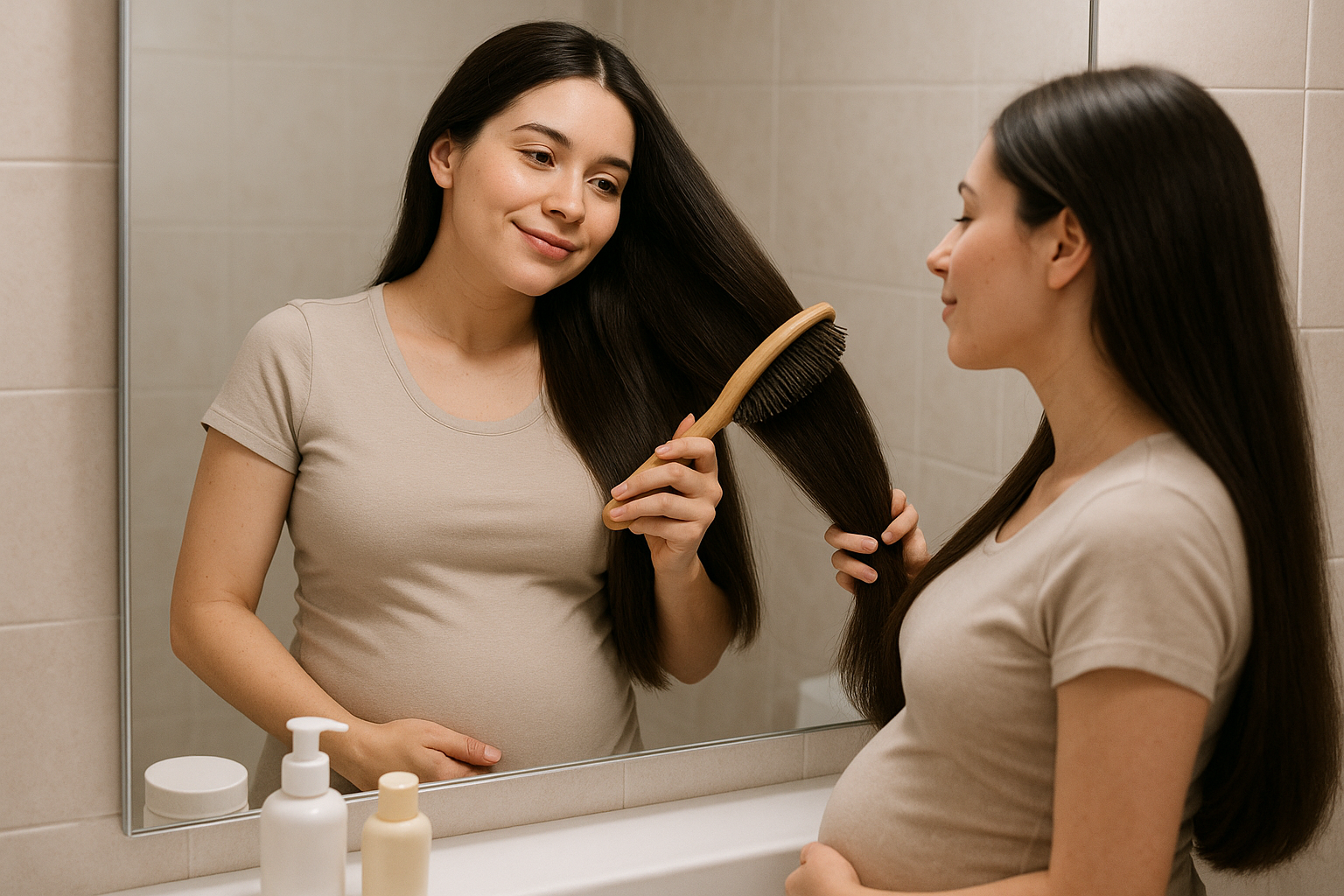
Conclusion
The pregnancy hair journey represents one of the most fascinating and emotionally charged aspects of expecting motherhood. From the initial glow and thickness that many women cherish during pregnancy to the inevitable shedding that follows delivery, this transformative experience encompasses both joy and concern for countless mothers worldwide.
Understanding that pregnancy hair changes result from natural hormonal changes helps normalize what can feel like an alarming process. When new mothers experience hair loss postpartum, it’s crucial to remember this represents a completely normal process that affects approximately 40-50% of women after childbirth. These dramatic shifts in hair density and texture aren’t signs of underlying health problems but rather evidence of your body’s remarkable ability to adapt and recover.
The reassuring reality is that postpartum hair loss is temporary. Most women notice significant improvement within 6-12 months as hormone levels stabilize and hair growth cycles return to their pre-pregnancy patterns. While the waiting period can feel lengthy, patience combined with proper nutrition, gentle hair care practices, and realistic expectations will support your hair’s natural recovery process.
Remember, every woman’s pregnancy hair experience is unique, but the journey toward restoration is virtually universal, offering hope and encouragement for the path ahead.
Frequently Asked Questions
No, postpartum hair loss is temporary. Most women see their hair return to pre-pregnancy thickness within 12-18 months after giving birth.
Postpartum hair loss cannot be prevented as it’s a natural hormonal process, but gentle hair care and good nutrition can support healthy regrowth.
Most women notice improved hair texture and reduced shedding during the second trimester, with peak effects in the third trimester.
References
- Grymowicz M, Rudnicka E, Podfigurna A, et al. Hormonal Effects on Hair Follicles. Int J Mol Sci. 2020;21(15):5342. PMID: 32731328
- Soma-Pillay P, Nelson-Piercy C, Tolppanen H, Mebazaa A. Physiological changes in pregnancy. Cardiovasc J Afr. 2016;27(2):89-94. PMID: 27213856
- Ramos PM, Miot HA. Female Pattern Hair Loss: a clinical and pathophysiological review. An Bras Dermatol. 2015;90(4):529-543. PMID: 26375223
- Hadshiew IM, Foitzik K, Arck PC, Paus R. Burden of hair loss: stress and the underestimated psychosocial impact of telogen effluvium and androgenetic alopecia. J Invest Dermatol. 2004;123(3):455-457. PMID: 15304082
- Lynfield YL. Effect of pregnancy on the human hair cycle. J Invest Dermatol. 1960;35:323-327. PMID: 13764567

